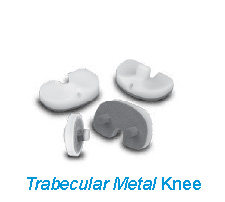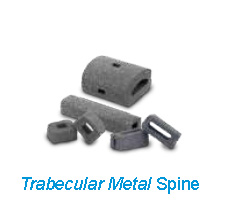No other porous metal material so closely resembles the structure, function, and physiology of Trabecular bone. Clinical studies in patients have shown that Zimmer Trabecular Metal Technology provides several unique advantages over other joint replacement materials:
- Greater initial stability between the new implant and your bone.1,2
- Excellent flexibility—a low modulus of elasticity (stiffness) that gives Trabecular Metal Material flexibility similar to that of your Trabecular bone which means an implant that moves and flexes with your normal bone.1,2,3,8
- A natural environment for your bone to heal and biologically attach to your new joint—its open-pore structure and fluid-flow characteristics facilitate bone integration, bone remodeling, and vascularization.3
- Bone mineral density may be better preserved beneath a Trabecular Metal tibial base plate compared with previous implant design.8
“Biologic fixation” vs. surgical cement
There are many types of replacement surgeries, whether for a knee or hip joint, the spine, or just to replace lost bone. The surgery involves removing or resurfacing damaged bone and then restoring it with replacement parts.
Some parts are attached to existing natural bone using special surgical cement. Others are called “cementless,” because they allow your biological tissue and bone to grow or heal directly into them. This “biological ingrowth” creates a more natural bond between the implant and the bone, and there is no need for surgical cement.
The quality of your existing bone and your activity level often determine whether you will receive a cementless joint, or if your procedure will require a cemented joint.
For active patients with acceptable bone quality, cementless techniques are often the preferred method. Trabecular Metal Monoblock components have been linked to a higher bone mineral density, which is important for solid fixation. Studies of porous tantalum (Trabecular Metal Material) have been shown to increase bone mineral density while solid titanium implants have been shown to decrease bone mineral density.4



Why porosity is so important
Imagine the roots of a plant. Bone is living tissue that grows into your implant, incorporating it into your body. The more porous the material—in other words, the more nooks and crannies it has—the easier it is for your biological tissue and bone to grow in and secure your new joint, making it part of your body. Other materials used for bone implants are only 35%-50% porous, but Trabecular Metal Material is up to 80% porous—the highest among known porous metal materials in the orthopedic market.1
The importance of flexibility
In addition to being strong and sturdy, healthy human bone has a certain degree of flexibility to help it bear the body’s weight and thrive under daily wear and tear. Trabecular Metal Implants possess flexibility similar to bone, whereas other implant materials are far more rigid. Studies have indicated that implant materials that don’t flex well may cause the underlying bone to recede and lose strength over time. Trabecular Metal Material Monoblock implants facilitate a more natural physiologic load transfer to the bone, minimizing stress shielding and lowering the potential for implant wear. This means your bones are stressed more normally and may respond by strengthening in proximity to the Trabecular Metal implant.1,5,6,7,8
For knee, hip, or spine
Trabecular Metal Material, used only in Zimmer replacement joints, has properties remarkably similar to Trabecular bone. And like Trabecular bone, it allows existing biologic tissue to grow right into it. With its excellent flexibility and stability, it’s simply The Best Thing Next To Bone.
Fixation Method for Total Knee Replacement
Demonstrated in this video is the biologic ingrowth into porous Trabecular Metal Material implant. This facilitates a more natural bond between the bone and the implant.
Fixation Method for Total Hip Replacement
Demonstrated in this video is the biologic ingrowth into porous Trabecular Metal Material implant. This facilitates a more natural bond between the bone and the implant.
